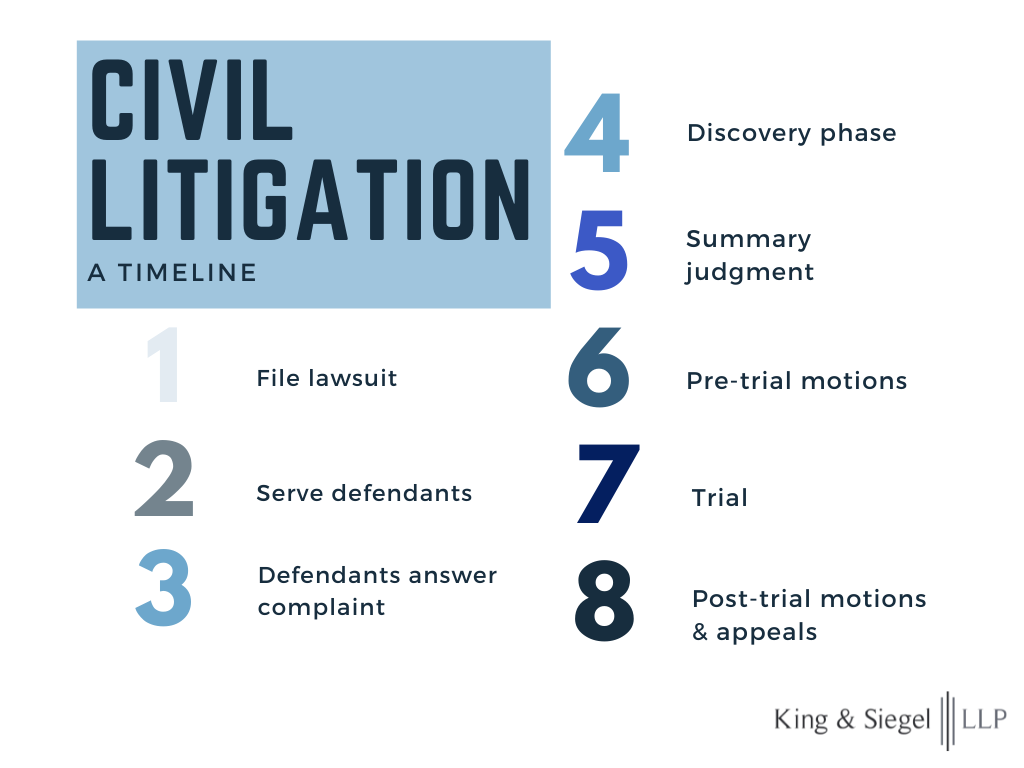
On TV, a case may be resolved in a single episode. People have their day in court just hours or even minutes after the case is filed. Unfortunately, this is not realistic. The real legal system is sometimes disorganized and involves backed-up court systems (especially because of COVID, which forced courts to stop holding trials for about a year).
Every once in a while, the employer realizes they broke the law or is immediately aware of the bad evidence. This is uncommon. Most of our firm’s cases become much stronger through the process called “discovery,” where we can take depositions and request documents from the other side. This evidence is key to proving your case and takes a long time to develop. This is especially true for discrimination, harassment, and wrongful termination cases.
So how long does this process actually take? What should you expect as a plaintiff in a lawsuit? We break it down for you here.
The Litigation Process
How Long Until My Case Settles?
Our average employment case settles about a year after the client signs an engagement agreement. This means some settle in a few months, but others take years. Many factors contribute to how quickly a case resolves. Factors include:
- The potential value of the case
- The strength of the evidence the client already has in her possession
- How much discovery is needed to convince the company of the risk in trying the case
- The defendants’ attorneys and their style of litigation (including whether they are trying to bill their client for more time and prolong litigation, which happens)
- The venue where the case is filed and how backed up its hearing calendar is
These are just examples.
Why Does Litigation Take So Long?
The litigation process can be slow, and it can be hard to understand because most people have not been parties to a lawsuit before. It can “feel” like nothing is happening, even when your lawyers are hard at work. Here is an overview of the steps involved in fighting your case in court.

 File Lawsuit
File Lawsuit
Your case starts when your attorneys file a legal document called a “Complaint.” The Complaint is a brief and description of the legal basis for your claims and lists the laws that were broken.
Once your case is filed, the Complaint must be “served” on the Defendants. This can be quick or take time, depending on whether the Defendants try to evade service. This must be done within 60 days of filing unless the Court orders otherwise.
Once the Defendants receive the Complaint, they must “Answer” (identify allegations that they deny) or file a motion to dismiss the Complaint. Depending on the method of service, Defendants must file their Answer or motion to dismiss within 30 to 45 days of receiving the Complaint.
Discovery Phase
After Defendants have been served with the Complaint, the case enters the discovery phase. “Discovery” is the legal process where both sides seek information to prove or disprove the allegations in the Complaint. Discovery can last anywhere from several months to several years, depending on the case. Attorneys often serve multiple “rounds” of discovery throughout the discovery phase, based on responses to prior discovery requests and other information unearthed in the discovery process. The main types of discovery are as follows:
- Written Discovery: Parties can serve and are required to respond to Interrogatories, or written questions under oath. Parties can also ask the other side to admit to facts relevant to the litigation.
- Document Discovery: By serving Requests for Production, both sides can request documents that are potentially relevant to the case from the other side and third parties.
- Depositions: At depositions, witnesses answer questions in person or by videoconference. Depositions are under oath. Plaintiffs are almost always deposed if their cases enter the discovery phase. In addition to the Plaintiff’s deposition, attorneys depose key witnesses who have personal knowledge of the facts alleged in the Complaint.
- Expert discovery: Some cases require testimony from “expert” witnesses to establish medical or scientific evidence. In employment cases, experts generally testify about your emotional distress, about workplace best practices, or about your economic losses. Expert discovery typically takes place towards the end of the discovery phase.
Discovery rules allow both sides to take discovery. This is because all parties are entitled to due process and fairness in court.
![]() Discovery is a battle! Defendants often refuse to turn over documents and plaintiffs’ lawyers have to file motions asking the court to require the Defendants to share certain documents with you. These motions can take months to be heard depending on the court and how busy the judge is. This is the single biggest reason discovery takes so long.
Discovery is a battle! Defendants often refuse to turn over documents and plaintiffs’ lawyers have to file motions asking the court to require the Defendants to share certain documents with you. These motions can take months to be heard depending on the court and how busy the judge is. This is the single biggest reason discovery takes so long.
Pretrial Conference & Pretrial Motions
Before trial, both sides will file motions about what evidence should be allowed at trial. The Court or arbitrator usually rules on these motions at the final pretrial conference.
Jury Trial or Arbitration Hearing
Trial starts with jury selection, followed by opening arguments. Both parties can call witnesses to testify at trial. Most employment cases take at least two weeks to complete jury selection, arguments, hearing evidence, and jury deliberations.
Post-Trial Motions & Appeals
After trial, parties can file motions to set aside the verdict. Parties can also appeal adverse verdicts. The appeals process can take several years and is not covered in this blog post.
When Do Employment Cases Settle?
While civil lawsuits can go through the pleading, discovery, and trial stages, most do not. About 95% of employment cases settle before trial. A skilled employment attorney should have a sense of how long your specific case might take to resolve (though of course things can happen that throw a wrench in these predictions).
Sometimes, the parties will make settlement offers through their attorneys. Other times, the parties will attend a day-long mediation. Mediation is an informal, non-binding dispute resolution process, usually before a former judge. Mediation is a chance for the mediator to discuss the case’s strengths and weaknesses with both sides and help recommend a fair resolution in a quicker and more efficient way than going to trial. Mediation can take place at any time.
DFEH & EEOC Cases Can Take a Long Time, Too
Sometimes, people choose to bring cases by filing their own complaints with the federal Equal Employment Opportunity Commission (EEOC) or the California Department of Fair Employment and Housing (DFEH). If the EEOC or the DFEH takes your case, they will act as your lawyers and charge you nothing. However, the EEOC and DFEH receive many more complaints than they can handle, so they cannot take on most cases presented to them. After a year, if they are still investigating your claims, the EEOC and DFEH will issue a “right to sue” letter telling you to find a private attorney. This can be frustrating as it essentially requires you to start from scratch.
If the EEOC or DFEH does accept your claims, they will litigate them in court on your behalf and the timeline will look like the one above.
Your Involvement as a Plaintiff in an Employment Case
As shown above, the litigation process can be long and drawn out. What does this mean for you as a plaintiff? This depends in part on your lawyer’s litigation style and your desired level of involvement in the case. For example, some clients like to review documents produced and attend the employer’s depositions. Others do not want this level of involvement.
In general, if your case is heavily litigated, you may need to:
- Pleadings/Demand Letters: Prepare timelines or witness lists and review factual allegations in the complaint or demand letter for accuracy.
- Discovery Responses: The defendant likely will serve written discovery requests seeking documents on your attorneys. The attorneys usually will prepare responses, but you will need to review them closely and collect responsive documents to share with the other side.
- Deposition: You may need to sit for a day or two of deposition testimony during the discovery phase of your case. Before the deposition, you will need to prepare for at least a few hours with your attorneys.
- Mediation: You may need to attend a mediation or settlement conference in an effort to resolve your case.
- Trial: Though few cases go to trial, if your case is tried, you will need to testify at trial. This will be similar to your deposition testimony except in the presence of the jury.
As you can see, employment cases require a close partnership between the law firm and their client. This is why you should choose counsel carefully (and why many law firms choose clients carefully). Learn more about selecting an employment lawyer here.
Contact Us for a Free Case Review
If you are concerned about the length of the litigation process, do not be discouraged. You should always contact an attorney to understand your options. For example, rather than trying to “maximize” damages and fight tooth and nail, some people would rather take a settlement upfront and move on. A good Los Angeles employment attorney will explain to you the tradeoffs of various strategies and tailor their choices for your goals.
We provide free, confidential consultations to California workers. You should contact us as soon as possible to make sure your claim is still within the time limits set by law. Contact us today through our website or give us a call at (213) 465-4802 to schedule a free consultation.


